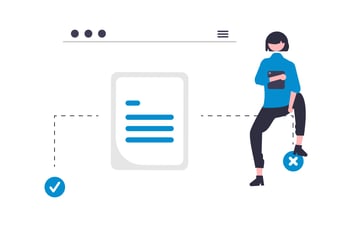How is a Customer Experience survey created?
The customer’s experience is the most important aspect of any business. If a customer has a bad experience, not only will they never buy from you again but they’ll share that experience and influence other people’s buying behaviour. But sometimes, the best way to discover the type of experience a customer is having with you is to ask, and then analyse the data.
If you’re ready to make the most of your customer’s input and improve your Customer Experience (CX), this article has everything you need to know. We explore survey tools, best practices, and all our top tips for leveraging Customer Experience data. Let’s get started.
How to collect and measure Customer Experience data
Customer Experience data (CX) measures what a brand’s customers encounter when interacting with it, at every touchpoint in the customer journey. That includes everything from customer service interactions, to using a product, to navigating the company website.
To collect and track Customer Experience data, you first need to:
- Determine your objectives.
- Choose a Customer Feedback Management platform (CFM).
- Create and distribute feedback surveys to all your customers.
Most CFM tools will include a survey building tool to help you design your surveys but even so, you need to follow these steps:
Determine the timing of your survey
Depending on your objectives, you need to decide what data to collect and when. Common examples are:
Post-purchase evaluations
Immediately after a customer purchases a product or service, it’s good practice to ask about their thoughts on the buying experience. They can let you know what led them to invest, what could have been done better, and any sticking points they came across.
Regular satisfaction surveys
You should always keep tabs on how your customers are feeling, which is why a weekly, monthly, quarterly or annual Customer Satisfaction (CSAT) survey is recommended. These highlight common trends and help flag problems your customers are facing before they become widespread.
When customers' responses are particularly positive, these are great opportunities to ask for an online review.
Customer service surveys
Anytime a customer interacts with your customer service team, it’s good practice to ask how it went. The surveys can be triggered after an interaction via live chat, email, phone call, or even in person. The responses customers give can identify common customer service issues so you can better equip your employees and deliver better service next time.
Develop your survey questions
Asking for feedback can be difficult, but once you know how to pose the right questions, it becomes a lot easier.
The key thing to remember is that customers don’t want to spend too much time completing surveys, so value their time and keep survey questions short and to the point.
Customer survey questions should:
- Be concise and easy to read.
- Be specific and relevant to the customer.
- Make sure they’re open-ended if you want to encourage elaboration.
- Never make assumptions.
- Be measurable with quantifiable metrics.
Examples of survey questions include:
- Was the website easy to use? (out of 5 or 10)
- How easy was it to solve your problem? (out of 5 or 10)
- What are the biggest challenges you faced using our product/service?
- How useful would a [new product] be for you? (out of 5 or 10)
For more inspiration, see this list of 18 questions for all types of Customer Experience surveys.
Choose a survey metric
One of the crucial steps of building a survey is deciding how to measure the results. Fortunately, there are multiple metrics available that assess customer survey responses and help to track trends over time.
Customer Satisfaction (CSAT)
Customer Satisfaction surveys are used to measure how happy customers are about a particular touchpoint in the customer journey. For example, you might ask a customer how they feel about the support they’ve received or how a purchase transaction went. You must always give a consistent scale for customers to rank their satisfaction on, such as 1-5 or 1-10.
Customer Effort Scores (CES)
If you want to identify sticking points in the Customer Experience, CES surveys are ideal. These questions assess how easy it is for a customer to interact with your brand, and are ranked on a scale of 1-5 or 1-10. These generally work in the reverse of most surveys. Here, a low score is good.
Net Promoter Scores (NPS)
NPS surveys offer an overall indication of how happy customers are by asking how likely they are to promote the brand to others. These are usually on a scale of 1-5 or 1-10 but we recommend pairing them with more specific questions like CSAT and CES to ensure you can act on the findings.
Choose Your Channel
Studies show that customers expect brands to adapt to their preferences, particularly in terms of which communication channels to use. When asking for feedback, you should make use of the channels that your target audience is actively using.
A multi-channel approach is proven to be more effective than sticking to one channel, and as technology constantly evolves, you need to be able to adapt to new trends.
For some customers, email and post will be most effective, while for others, social media and website popups are better suited. Simply take note of the channels you most commonly engage with customers on and use those. That’s why Review Tui uses flexible Campaign links that can be distributed across any channel.
When communicating with customers, you should:
- Be where they are, don’t force them to use a tool they don’t already use.
- Make it as easy and streamlined as possible.
- Be personal and responsive at all times.
Implement open-text fields
You can never seek to collect all feedback from one survey because the Customer Experience is ongoing and dynamic. That’s why it’s worth building multiple surveys for different touch points. With each, it's worth using open-text feedback fields so that customers can give feedback that's expansive and goes beyond the questions being asked.
These text fields are open-ended and immediately accessible at the right time, meaning customers don’t have to go looking for an opportunity to speak up. This way you’ll get more customer feedback, and know exactly which page or topic they’re referring to.
Use your Customer Feedback Management tool
The most impactful step you can take when creating surveys is to use a CFM platform. A good CFM tool should:
- Include a user-friendly survey builder.
- Distribute surveys on the channels your customers use.
- Collate all the survey data onto one dashboard.
- Analyse the results to extract powerful insights.
- Identify common trends in the Customer Experience.
- Integrate with your CRM and existing business tools.
The Review Tui platform is designed to track and improve the Customer Experience for New Zealand businesses. If you want to connect with customers and understand how your brand is performing, Review Tui Customer Experience surveys are your tool to get there.
With the Hubspot integration, a variety of CX metrics, and helpful tips, you’ll have everything you need to transform your Customer Experience. Why not start mapping your customer feedback journey by downloading our free digital guide?



